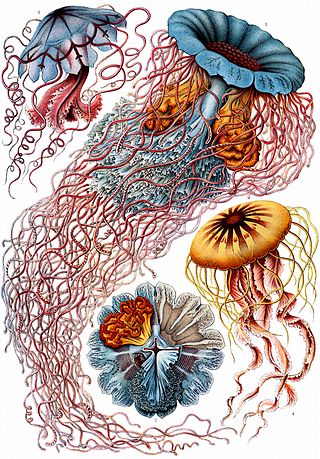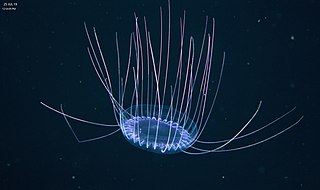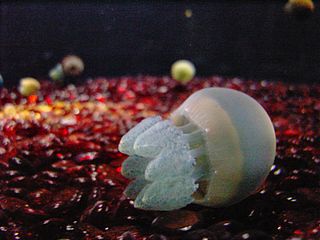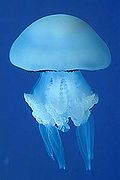
The Scyphozoa are an exclusively marine class of the phylum Cnidaria, referred to as the true jellyfish.

Discomedusae is a subclass of jellyfish in the class Scyphozoa. It is the sister taxon of Coronamedusae. Discomedusae contains about 155 named species and there are likely to be many more as yet undescribed. Jellyfish in this subclass are much more likely to have swarming events or form blooms than those in Coronamedusae. Discomedusae consists of two orders, Rhizostomeae and Semaeostomeae.

Phyllorhiza punctata is a species of jellyfish, also known as the floating bell, Australian spotted jellyfish, brown jellyfish or the white-spotted jellyfish. It is native to the western Pacific from Australia to Japan, but has been introduced widely elsewhere. It feeds primarily on zooplankton. P. punctata generally can reach up to 50 centimetres (20 in) in bell diameter, but in October 2007, one 72 cm (28 in) wide, perhaps the largest ever recorded, was found on Sunset Beach, North Carolina.

Cotylorhiza is a genus of true jellyfish from the family Cepheidae. The genus is found in the central-east Atlantic, Mediterranean, and western Indian Ocean.

Stomolophus is a genus of true jellyfish from the West Atlantic and Pacific. It is the only genus in the monotypic family Stomolophidae. Formerly, Nomura's jellyfish was also included in this genus, but has now been reclassified to the family Rhizostomatidae.

Solmissus, or dinner plate jellyfish, is a genus of hydrozoans. Its species are unique among cnidarians in that they actively hunt for prey as opposed to passively waiting for plankton to pass by. They are found in the deep waters of Monterey Bay, California. They are most likely to be found in the deep sea, mid water. They grow to be 20 cm (7.9 in) in diameter. These hydrozoans feed on gelatinous zooplankton, including salps and doliolids, ctenophores, jellyfish, and copepods. However, Solmissus may be limited to feeding on soft-bodied prey by the type of nematocysts on their tentacles (Mills).

Cyanea is a genus of jellyfish, primarily found in northern waters of the Atlantic and Pacific Oceans and southern Pacific waters of Australia and New Zealand, there are also several boreal, polar, tropical and sub-tropical species. Commonly found in and associated with rivers and fjords. The same genus name has been given to a genus of plants of the Hawaiian lobelioids, an example of a parahomonym.
Marivagia is a monotypic genus of jellyfish, containing only the species, Marivagia stellata, that was first described in 2010 following the discovery of several specimens on the Mediterranean coast of Israel.

Catostylidae is a family of jellyfish. Members of this family are characterized by their thick, sausage-like oral arms.

Cuninidae is a family of hydrozoans in the order Narcomedusae. They have dome-shaped bells and tentacles set above the undulating margin of the bell. Their gastric pouches contain the gonads situated in line with the tentacles, the number of pouches being the same as the number of tentacles. The pouches do not extend below the points of origin of the primary tentacles. Members of some genera have a peripheral canal system and others do not. No radial canals or secondary tentacles are present.

Cephea is a genus of true jellyfish in the family Cepheidae. They are found in the Indo-Pacific and eastern Atlantic oceans. They are sometimes called the crown jellyfish, but this can cause confusion with the closely related genus Netrostoma or the distantly related species in the order Coronatae. They are also sometimes called the cauliflower jellyfish because of the cauliflower-looking form on top of its bell.

Rhizostomatidae is a family of cnidarians in the class Scyphozoa.

Catostylus is a genus of jellyfish in the family Catostylidae.

Alatina is a genus of box jellyfish within class Cubozoa. It is the largest of the three known genera in the family Alatinidae, and the only one which is not monotypic. It contains the following ten species:

Some species of jellyfish are suitable for human consumption and are used as a source of food and as an ingredient in various dishes. Edible jellyfish is a seafood that is harvested and consumed in several East and Southeast Asian countries, and in some Asian countries it is considered to be a delicacy. Edible jellyfish is often processed into a dried product. Several types of foods and dishes may be prepared with edible jellyfish, including salads, sushi, noodles, and main courses. Various preparation methods exist.

Rhopilema verrilli, or mushroom cap jellyfish, is a species of jellyfish in the family Rhizostomatidae. They are cnidarian invertebrates distinguished by their mushroom-shaped medusae. The species does not have any tentacles; however, they still have stinging cells, called nematocysts, within their bells, which can produce mild stings to humans.

Thysanostomatidae is a family of true jellyfish from the Indo-Pacific. The first sighting of Thysanostoma loriferum in Hong Kong; extending its known range from the Philippines, the Malay Archipelago, and Hawaii; was from the Hong Kong Jellyfish Citizen Science project and sightings on iNaturalist.
Crambionella is a genus of cnidarians belonging to the family Catostylidae. It is distinguished from other Catostylidae genera by arms ending in pyramidal and naked terminal clubs without whip-like filaments. The species of this genus are found in the coasts of Indian Ocean, the Arabian Sea, and the Red Sea. The first identification of this genus was C. orsini in the Red Sea in the waters of Chennai and later the Gulf of Oman and the Strait of Hormuz. At least one species, C. helmbiru, is raised commercially for food in the Cilacap region of Java.

Zanclea is a genus of hydrozoans belonging to the family Zancleidae.

The golden jellyfish is a subspecies of spotted jellyfish that inhabits Jellyfish Lake on Eil Malk island in Palau in the western Pacific Ocean. Like the nominate subspecies, it derives part of its nutrition from symbiotic algae (Zooxanthellae) that live in their tissues and part of their nutrition from captured zooplankton.

























